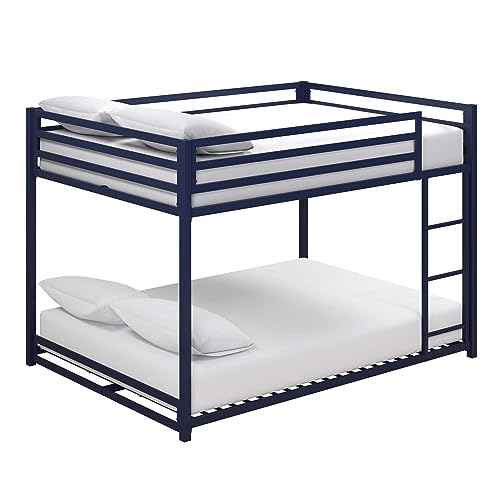The Advanced Guide To Bunk Bed With Double Bed

Buying a Double Size Bunk Bed
A bunk bed adds both aesthetics and practicality to a bedroom. It's a great option for siblings sharing a room, or teens who want to invite friends to have a sleepover.

Be aware of the ceiling height of the room when looking for a double-sized bunk bed. Also, decide whether you want the lower bunk to have a trundle, so that additional guests can sleep on it. Also, look for an incline or ladder that are wide enough for smaller teens and children to climb with ease.
Size
There are many options if you're considering buying a bunk bed. There are many options such as twin over twin, twin over full or even triple bunk beds. These bunk beds are designed to fit two or more people, so you can make the most of your bedroom space without sacrificing safety or comfort. Bunk beds are also easily disassembled to make two twin mattresses when needed. This allows you to repurpose your bunk bed in the future, should your children no longer require it or if you want to save money on new headboards and foundations.
It's important to remember that the dimensions of your bed will determine which mattress is right for you. You can choose a twin-sized mattress for your top bunk, or a twin mattress that is 5 inches larger. This is a great option for teens, as it provides extra length for those who are taller. You can also opt for a futon-style bunk bed with a pull-out sofa at the bottom of the frame. This provides more space for sleep to adults or teenagers.
The height of your bunk bed should be considered because you don't want to purchase mattresses that are too high and you risk hitting your head against the ceiling when you lay down. A best practice is to make sure there's a minimum of six to eight inches of clearance between the mattress and the upper guard rail, so sleepers can comfortably lay down in bed.
You might also consider the dimensions of your bunk bed ladder in relation to the dimensions of the room. Most bunk beds come with straight ladders, however you can also purchase stairs-style or angled bunk bed ladders. Staircase-style ladders occupy more space but are usually safer than a straight ladder. Bunk bed ladders come in a variety of heights. This is helpful when you have children that are growing and might need to change rooms.
Some bunk beds can be divided to create a lofted bed, which will give floor space to furniture, a dresser or desk toys. This can be a fantastic option for older children or teenagers who don't wish to share their rooms anymore because it allows them to have their own spaces with confidence.
Material
Double bunk beds can be found in a variety of materials. Solid wood is the most durable and robust choice, while less expensive metal is a good option for budget-conscious shoppers. Bunk beds are also available in particleboard and engineered wood. However, these kinds of materials don't last as long as solid wood and they may emit volatile organic compounds (VOCs) which could cause harm to children's respiratory, immune, or allergic systems.
Another important aspect to consider when choosing a bunk bed is the height of the top bunk. A bed that is too tall could cause people to fall from the top bunk or fall and hit their head against the guard rails. A bunk bed should be not higher than 6 feet above the floor.
For a contemporary design, this bunk bed with trundle pullout offers elegant lines and a timeless style. The angular frame tucks neatly into the corner of your kids' bedroom, and the space underneath can be used as a study area with desk or a relaxing place to relax with a comfy throw pillow and a graphic comforter. This chic bunk bed is crafted of kiln-dried pine wood and durable engineered wood for lasting durability and strength. The bed is hand-finished with the finish of your choosing either white or seadrift. The bed's modern, clean lines are complemented by polished nickel or oil rubbed bronze hardware.
These bunks are a great option for kids who have outgrown their toddler or child's beds but are too tall to fit in the standard twin beds. They're also great for adults who want to share a room with a younger sibling or a college student living in a small space. This twin over full bunk bed comes with a ladder and two under-bed storage drawers that are a convenient place to stash bedding and clothing.
This bunk bed does not require a box spring or foundation, unlike traditional bunk beds. Instead the beds are stacked on one another and can accommodate a traditional or a memory foam mattress. Memory foam mattresses are known to be comfortable, however they are more expensive than innerspring or coil mattress.
Design
If your kids share a room and want to share a bed, bunk beds can provide more sleeping space without taking up more floor area. Bunk beds are available in a variety of styles and configurations, and many even include extra features like desks that are built-in, stairs and trundles. While you can find bunk beds that are already made at many major furniture stores, you can also build a custom-designed bunk bed for your home to accommodate any space size and style.
When you are choosing a loft bed, you should think about the dimensions of your room as well as the height of your ceiling. Larger rooms can accommodate a larger mattress but smaller rooms require twin mattresses to prevent the possibility of crowding. Moreover, you must ensure that your children's heads will not be struck by the ceiling when they sleep on the top bunk.
A basic bunk bed could be constructed with two twin-sized mattresses, and some variants feature full-size mattresses on the bottom and a twin on top. These bunks are perfect for siblings sharing a single room or older children who want more space to play and study. They are an excellent choice for bedrooms with small spaces, since they will free up floor space for other furniture pieces like dressers, desks, and toy boxes.
Other types of bunk beds include loft beds which can be used as a playroom or office and can double as a bed for guests to visit. They come in a range of finishes ranging from traditional to contemporary and are usually constructed using sturdy wood. Some even come with built-in shelves to store books and other items.
The L-shaped double bed provides more privacy and can be adapted to fit in with any bedroom. It is also safe to use, as it includes a staircase with safety rails as well as a built-in desk which makes it a great option for children who need to do their homework or perform other things in the bed.
If you have a bigger budget, you can opt for a double over queen-size bunk bed with a built-in staircase and a bed with a trundle. This bunk bed comes with more storage space and can hold more guests than the standard bed. Its large design is perfect for teenagers and can be customized to match any decor or finish.
Safety
While injuries to bunk beds can occur, they are usually caused by the way that children use the beds and not due to the design or construction. With a few basic security precautions, bunk beds can be safely used by children of all ages.
Before you put together your bunk bed, you must decide the location you'll put it and then measure the dimensions of the room. This will help you determine if the bed is going to fit and whether there will be enough space for sleeping or playing. Be sure to check the height of the ceilings to avoid placing the bunk beds in ceiling fans or lights.
Always follow the manufacturer's instructions when assembling your bunk bed. This will ensure that all the components are correctly fitted and ensure that your bunk bed is solid. Check the components on a regular basis and replace any that look worn or damaged. Also, ensure that the ladders are securely attached to the bunk beds and that they are able to support the weight of your child as well as any other guests that might be sleeping over.
Inform your children about the rules for using bunk beds. bunk double beds should only be used for sleeping and not for games or jumping. The ladder must also be connected to the bunk and not placed close to any furniture or toys that might encourage children to climb it. The children should also be taught how to climb the ladder safely and slowly.
When assembling your bunk bed, consider using ladders that attach to the bed's side instead of one that is beneath it. This will decrease the risk of falling or getting caught with bedding or clothing. Also, think about installing an extra night light in the room near the bunk bed. This will help your children feel more secure when climbing into and out of bed at night.
It's also a good idea to check the spaces and openings on the guardrails as well as in the mattress's foundations before you allow your kids to sleep there. The openings should not be wider than 5 inches and shouldn't be located in a place where your child's head might hit if they are seated upright on the bunk above.
